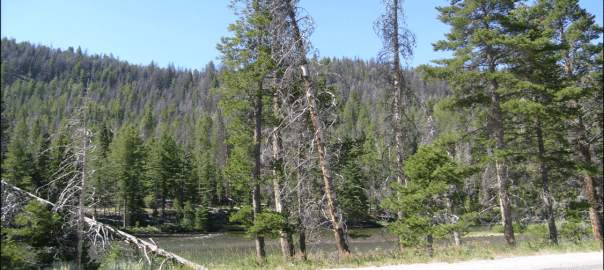In 2013 the Idaho legislature approved House Concurrent Resolution (HCR) 21 and HCR 22. These resolutions authorized appointment of an Interim Legislative Committee to complete a study on the process of the State of Idaho acquiring title to and control of public lands in our State. That ten-member committee met during the legislative interims in 2013 and 2014, and on January 20, 2015, completed their Final Report1.
The committee’s report is well-researched and written, and provides a detailed background of the history of federal lands ownership and disposition nationwide; a summary of the two house resolutions2; an outline of the committee’s work; a review of key issues; and the committee’s preliminary findings and recommendations.
I find no substantial flaw in the report except for three concerns I have with the economic “cost analysis” on pages 17 and 18. I agree with the committee’s recommendation on p. 27 that an additional economic analysis should be conducted. First, the cost analysis appears to be inappropriately based on current cost/revenue figures for the highly inefficient and cost-ineffective federal agencies. Second, it presumes ongoing mismanagement of those federal public lands as extensive “national preserves,” used primarily for recreation purposes, rather than for the productive and revenue-generating purposes for which the lands were authorized by the Taylor Grazing Act, National Forest Management Act (NFMA), Multiple-Use Sustained-Yield Act (MUSYA) and Federal Land Policy Management Act (FLPMA)3. And third, it assumes continuation of an enormous and costly bureaucracy of work locations and personnel. (The same acreage of public lands used to be managed by a handful of district rangers!) I suspect that an economic analysis based on more efficient management by the state, without the encumbrance of federal regulations such as the National Environmental Policy Act (NEPA) and with a management philosophy of revenue-generating production of our natural resources, will yield substantially different figures than those presented in the report.
After reviewing the committee’s report, I have my own recommendations to offer in response to the committee members’ analysis and suggestions.
Most important, I believe the state should seek a total transfer of all federal lands within our borders, except for properties related to national defense and possibly the two designated wilderness areas (Selway-Bitterroot and Frank Church River of No Return). Federal lands would include not only Forest Service and BLM lands, but also those that have been designated by Congress as special management areas (e.g., the Wild and Scenic River segments of the Middle Fork and mainstream Salmon Rivers, Hells Canyon National Recreation Area (Idaho portion), Sawtooth National Recreation Area, Snake River Birds of Prey National Conservation Area, Craters of the Moon National Monument, Curlew National Grassland, City of Rocks National Reserve, and the Camas, Kootenai, and Gray’s Lake National Wildlife Refuges). These designated lands encompass an extensive portion of our state’s land base, are proven revenue-generating recreation areas, and in many cases, use of public lands adjacent to those designated areas must be coordinated with use of those special designation areas. The lands transfer could presume initial management direction under the guidelines of the Congressional enabling legislation and current approved management plans, with the State of Idaho given authority to change that management direction within a future specified timeframe of perhaps 10-25 years. It would not benefit the State to seek partial control or a compact arrangement to manage, but not “own” federal lands, because the federal lands would still be subject to the incredibly costly, inefficient and litigious NEPA planning process.
Second, and equally important, I think the vast majority of transferred lands should remain “public” lands where the resources are utilized for the benefit of the people of Idaho. The lands should not be disposed of to add to the private land base except for small tracts where it makes sense to “block up” land ownership for efficient administration and/or improved access to resources. A formula should prescribe the percent of revenues which are paid to the state education fund, a state natural resource management fund (drawn upon to pay for the costs of natural resource management), state highways fund, and state law enforcement. (Revenues should only go towards funding functions of state government which serve the general population.) The state might also consider cooperative agreements and revenue percent allocations to the counties which have public lands within their borders, to compensate those counties for their lower private property tax base and to acknowledge that counties should also benefit from the natural resources within their borders.
While the transfer of title of federal lands to the State of Idaho is being pursued, Congress could take several actions that would immediately benefit all of the Western states with extensive federal lands:
- Require strict application of the production, revenue-generating direction of the Taylor Grazing Act, MUSYA, FLPMA, and NFMA, and stop treating Forest Service and BLM lands like national preserves! Section 4 (b) of the Multiple-Use Sustained-Yield Act is particularly relevant: “‘Sustained yield of the several products and services’ means the achievement and maintenance in perpetuity of a high-level annual or regular periodic output of the various renewable resources of the national forests without impairment of the productivity of the land” (emphasis added). It is within the authority of Congress to set production quotas for these lands! For example, current timber production is only a fraction of the expected productivity twenty years ago. Our local sawmill shut down decades ago due to a lack of “regular periodic output of the various renewable resources of the national forests.”
- Direct the Secretary of Agriculture to enter into a formal cooperative agreement that allows the Western states and interested local governments to directly participate in management of the national forests. A formal agreement would far exceed the current “collaboration” that has been attempted with limited success. This cooperation is expressly encouraged by the Multiple-Use Sustained-Yield Act, Section 3: ‘In the effectuation of this Act the Secretary of Agriculture is authorized to cooperate with interested State and local governmental agencies and others in the development and management of the national forests.”
- Establish a moratorium on any new monument, wilderness, or other special designations by Congressional or Executive Action while the states are contending with the federal government over transfer of title and management control.
- Increase the percent of federal revenues paid to the states which have federal lands within their borders. Rather than only paying 25%, at least 50% if not 80% of recreation fees, grazing fees, timber sale receipts, minerals royalties, and other revenue-generating activities on federal lands should be paid to the states. I would recommend that half of the percentage be paid to the state education fund and half be distributed to the affected counties, based on the percentage of federal lands in the county’s borders. This would replace the current PILT and SRS programs, leaving just the percent revenue sharing in place.
- Amend NEPA and its implementing regulations to reduce the extent of analysis required (the initial intent was a 30-page document!) and eliminate frivolous appeals and litigation. This action alone would streamline the cost and timeframe of natural resource project planning and implementation.
The study has some unanswered questions, such as how would a transfer of federal lands to state control affect tribal treaty rights to hunt, fish, and gather natural resources on those lands. I am sure there are many other questions about and reactions to the committee’s report. I encourage all Idaho citizens to read the report and share your views with the Idaho legislature and our federal representatives. The committee has done an excellent job of fulfilling the direction of HCR 21 and 22. Let the rest of us now take part in the debate and work toward a viable solution.
1. The Final Report of the Interim Legislative Committee can be viewed here:
2. HCR 21 and HCR 22 can be viewed here:
- http://legislature.idaho.gov/legislation/2013/HCR021.htm
- http://legislature.idaho.gov/legislation/2013/HCR022.htm
3. The Taylor Grazing Act, MUSYA, FLMPA, and NFMA can be viewed here:
- http://www.publiclandscouncil.org/CMDocs/PublicLandsCouncil/Taylor%20Grazing%20Act%20-%201934.pdf
- http://www.fs.fed.us/emc/nfma/includes/musya60.pdf
- http://www.blm.gov/flpma/FLPMA.pdf
- http://www.fs.fed.us/emc/nfma/includes/NFMA1976.pdf
Evalyn Bennett worked for fifteen years as a BLM and Forest Service planning team member and writer-editor for land use plans, project plans, and associated environmental analyses.



